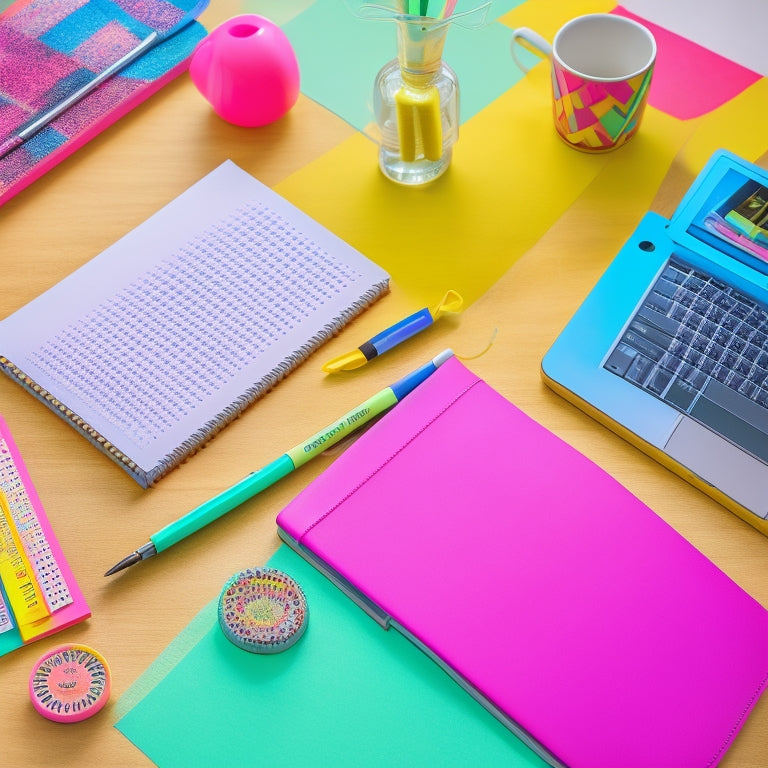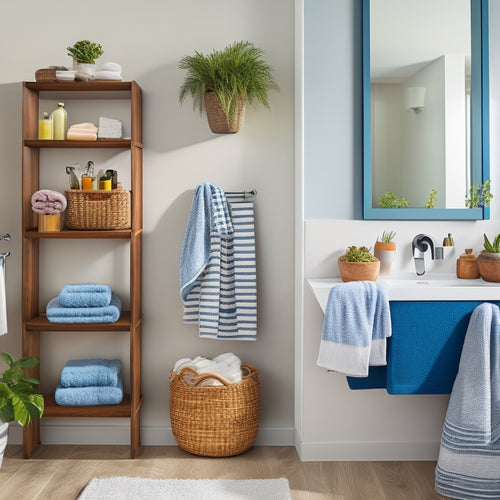
Boost Productivity: Mastering Paper Planner Organization
Share
I've mastered paper planner organization and it's been a game-changer for my productivity. To get started, I prioritize tasks using daily to-do lists and tailor my planner to fit my unique needs. Effective time management techniques and allocating specific time slots for each activity have also been key. But it's not just about being productive - I've also learned to transform my planner into a memory keeper, reflecting on cherished moments and milestones. By combining these strategies, I've taken my productivity to the next level. Let's dive deeper into the essential tools and techniques to boost your productivity too.
Key Takeaways
• Utilize daily to-do lists and prioritize tasks to stay focused, ensuring maximum productivity and organization.
• Allocate specific time slots for each activity, implementing effective time management techniques to avoid procrastination.
• Customize the planner with personalized layouts, stickers, and decorations to make it visually appealing and engaging.
• Break down large goals into smaller, manageable steps, and schedule regular review sessions for progress assessment.
• Set clear, achievable monthly goals and track progress to boost productivity and motivation.
Organizational Tools for Success
I rely on daily to-do lists, essential for staying focused and organized, to help me remember tasks throughout the day and keep me on track and productive. These lists enable me to prioritize tasks, break them down into manageable chunks, and allocate specific time slots for each activity.
Through creative customization, I tailor my planner to fit my unique needs, incorporating stickers, colors, and symbols to make it visually appealing and engaging. Effective time management is key, and my planner helps me allocate time wisely, ensuring I complete tasks efficiently and make the most of my day.
Memory Keeping and Personalization
Incorporating personal touches into my paper planner transforms it into a memory keeper, allowing me to reflect on cherished moments and milestones. I achieve this by printing Polaroid memories using my Polaroid Zip and adding them to my weekly spreads twice a week.
This way, I can relive happy moments and share them with family members. I also customize my planner with personalized layouts, stickers, and decorations that match my personality. This makes my planner truly unique and enjoyable to use.
Long-Term Planning and Tracking
Regularly tracking long-term goals and tasks in my paper planner helps me stay focused on what's truly important and avoid last-minute stress. By planning ahead, I can break down large tasks into smaller, manageable chunks, making progress feel more achievable.
Here are three ways I use my paper planner for long-term planning and tracking:
-
Gift planning: I track gifts to be purchased for upcoming birthdays and holidays, making sure I stay on budget and avoid last-minute scrambles.
-
Goal setting: I set and track progress towards my monthly goals, helping me stay focused on what's truly important and celebrate my achievements.
-
Long-term task management: I break down large projects into smaller tasks, tracking progress and deadlines to make sure timely completion.
Choosing the Right Planner
With a plethora of paper planners available, selecting the right one can be a challenging task, especially when it comes to finding a layout that resonates with my unique planning style and lifestyle.
As I search for the perfect planner, I consider the size that fits my lifestyle and purse. I evaluate the weight and bulkiness for portability, ensuring it's easy to carry around. The layout is essential, as it needs to align with my planning style and goals. I explore options like travelers' notebooks for variety.
I prioritize organization, opting for a planner that provides ample space for notes, to-do lists, and goal setting. By choosing the right planner, I set myself up for success, creating a system that enhances my productivity and overall organization.
Planning Style Comparison
As I explore the world of paper planning, I find myself drawn to a comparison of electronic and paper planning methods, each with their unique benefits and drawbacks that cater to different personalities and organizational styles.
When it comes to planning, I've found that people tend to fall into one of three categories:
-
Digital devotees: Those who swear by the convenience and accessibility of electronic calendars and reminders.
-
Analog enthusiasts: Those who prefer the tactile experience of writing and crossing off tasks by hand.
-
Hybrid heroes: Those who combine the two, using digital tools for communication and paper planning for organization and memory retention.
Ultimately, the key to effective planning lies in understanding your personal preferences and finding a system that works for you.
Effective Planning Strategies
I've identified three essential strategies that help me optimize my paper planner's effectiveness:
-
Prioritizing tasks: By prioritizing tasks, I focus on the most critical ones first, ensuring I allocate my time wisely.
-
Breaking down large goals into smaller steps: Breaking down large goals into smaller, manageable steps enables me to make steady progress and avoid feeling overwhelmed.
-
Scheduling regular review sessions: Regular review sessions allow me to assess my progress, adjust my strategy, and refocus on my goals.
These strategies have greatly improved my time management and task prioritization skills, enabling me to stay on track and achieve my objectives. By incorporating these strategies into my paper planner routine, I've experienced a considerable boost in productivity and efficiency.
Mastering Paper Planner Essentials
When it comes to mastering paper planner essentials, understanding the organizational tools that work best for me is key to staying focused and productive.
To achieve this, I prioritize three essential tools:
-
Daily To-Do Lists: Breaking down tasks into manageable chunks helps me stay on track and tackle priorities.
-
Task Prioritization: Identifying critical tasks and allocating sufficient time guarantees I meet deadlines and make progress.
-
Time Management: Scheduling tasks according to their urgency and importance enables me to optimize my day and make the most of my time.
Frequently Asked Questions
How Do I Avoid Over-Decorating My Planner and Losing Functionality?
I avoid over-decorating my planner by embracing a minimalist approach, focusing on functional aesthetics that enhance organization, and resisting the urge to add unnecessary embellishments that can clutter and distract from its purpose.
Can I Use a Paper Planner if I Have Poor Handwriting?
"I don't let poor handwriting hold me back from using a paper planner; instead, I practice handwriting tips like slowing down and using guidelines, and do writing exercises to improve my script, making planning a breeze."
How Often Should I Review and Adjust My Planner Setup?
I review and adjust my planner setup every 4-6 weeks for a Planner Refresh, ensuring Goal Alignment by reflecting on progress, updating layouts, and fine-tuning my system to maximize productivity and stay organized.
Are There Any Planners Specifically Designed for Students or Entrepreneurs?
"I'm not a traditional student or entrepreneur, but I've found planners designed for these groups offer incredible customization options, perfect for my busy schedule. Look for planners with flexible layouts and goal-setting sections to maximize productivity!"
Can I Use a Paper Planner in Conjunction With Digital Calendar Apps?
I combine my paper planner with digital calendar apps by implementing syncing strategies, avoiding app overlap, and using each tool for its strengths - the planner for goal setting and reflection, and apps for real-time reminders and notifications.
Related Posts
-

Wall-Mounted Bathroom Storage for Family Homes
Wall-mounted bathroom storage is a transformative solution for your family's space. It cleverly maximizes vertical ar...
-

High Road Car Glove Box Organizer Review
The High Road Car Glove Box Organizer is a top-rated solution for keeping vehicle documents and essentials neatly org...
-

Discover Essential Korean Vocabulary for Beginners
You'll need to master a range of essential Korean vocabulary to effectively communicate and navigate everyday situati...


